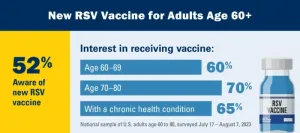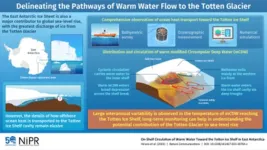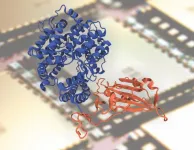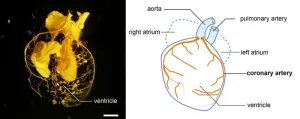(Press-News.org) COLUMBUS, Ohio – Train elementary school students how to be creative and you can help increase their resilience in the face of real-life problems, new research suggests.
In a small study, researchers trained third, fourth and fifth graders to use literary techniques such as perspective shifting, counter-factual (what if) thinking and causal (why) thinking to improve creativity in dealing with difficulties.
The techniques helped kids come up with new, creative and practical ways to solve problems, said Angus Fletcher, lead author of the study and a professor of English at The Ohio State University and member of the university’s Project Narrative.
“There are concerns about the resiliency of American children in the wake of COVID-19 and this sense that many kids are having a hard time in school and in life,” Fletcher said.
“Creativity training can help kids come up with a second plan when things aren’t working out for them.”
The study was published recently in the Journal of Creativity.
Fletcher said the program used to help kids in this study was similar to one he and his colleagues used successfully with the U.S. Army – and which resulted in Fletcher receiving the Public Service Commendation Medal, the fourth-highest public service decoration that the Army can bestow upon a civilian.
The researchers did two separate studies involving students attending a summer camp in a Columbus suburb.
In one study, 32 students were split into two groups. In the control condition, the children were told to identify a special quality about themselves. They were told this was their special power that could help them solve any problem.
In the creative condition, the students were told to think of a friend who did something special and think of them as their “creative friend” who could help them solve any problem. This type of creativity training is called perspective-shifting, in which the kids look at a problem through the eyes of someone else.
“When you ask people to shift their perspective and imagine receiving advice from a friend, you get a lot more creative and effective solutions to problems than just trying to solve the problem yourself,” Fletcher said.
And that’s what the study found. In one part of the study, teachers identified a problem that was challenging for their students – for example, not being able to go to a friend’s birthday party because you’re going to be out of town with your parents.
Students also thought about a challenging problem in their own lives. Some problems that were mentioned included “my brother has a communication disorder,” “my dad has to be away for two months” and “my sister bullies me.”
Results showed that without the perspective-shift training, fewer than half of the students were able to provide a solution to the age-typical problems and almost none were able to provide a solution to their own problems.
But 94% of those who were trained in perspective-shifting provided a solution to both.
Judges (who were trained teachers) also rated the children’s solutions on creativity, as assessed by how surprising or unique the solutions were.
With the intervention, the average creativity score was 6.44 out of 10 (moderate creativity) compared to 3.05 (low creativity) for those who did not receive the perspective-shifting intervention.
These results showed how creativity training could boost children’s sense of self-efficacy – the belief that they had some control and power over their own lives, Fletcher said.
When considering their own problems, most of the children who received the intervention came up with a potential solution. But 15 of 16 children in the control group essentially gave up, Fletcher said. They either said they didn’t know how to fix their problem, or displayed some version of magical thinking, such as saying they could become a superhero.
A second longitudinal study involving 28 students in the same camp was designed to test the effects of a five-day, 10-hour narrative creativity curriculum on creativity, self-efficacy and resilience.
In addition to perspective-shifting, the students were also trained in other narrative creativity techniques, such as causal thinking, Fletcher said.
“If children can’t solve a problem, we train them to back up and think about what they are trying to accomplish – the why problem,” Fletcher said.
“Step back and say why does this matter? We often find that if you think more broadly about what you are trying to accomplish, and why it is so important, then you can see there are other ways of getting what you want.”
At the end of the curriculum, the students were presented with age-typical problems similar to the first study and also examined one of their own problems.
In order to test resilience, the researchers provided an unexpected challenge when the children presented their proposed solution to their problems: they told the kids it wouldn’t work.
Results showed that every student who took the five-day curriculum was able to provide a second solution to both the age-typical and personal problems.
“With this training, the children were unfazed by being told their first solution didn’t work. They came up with a second plan, which is a good test of resilience,” Fletcher said.
And the second solution to the problems averaged higher creativity scores from the judges – 7.5, which indicated moderate to high creativity, compared to 5.45 for their first solution.
Second solutions also scored higher on utility, which is how likely they are to succeed in the real world.
Fletcher said this study provides a hopeful message: There are things we can do to help children cope with their problems.
“We are at this moment in our society where our kids need help. We found that before this training, kids had this propensity to just give up when faced with problems. That could lead them to get angry, or embarrassed that they can’t solve their problems, or look for adults to offer solutions.”
What narrative creativity training can do is teach children there are ways to approach real-life problems that don’t have easy answers, he said.
Fletcher said that kids can learn creativity through the arts, such as literature and theater, if they are done the right way. Rather than just asking students to analyze works of art, teachers can have students imagine themselves as different characters, explore new perspectives and engage in why and what-if thinking.
“The ability to use this type of thinking can’t be assessed via standardized tests. But it is still very important and can help children use and grow their creativity to solve real-world challenges,” he said.
Fletcher conducted the study with Ohio State colleagues Patricia Enciso, a professor of literature for children and young adults in the College of Education and Human Ecology, and Mike Benveniste, also of Project Narrative.
END
Want to increase resiliency in kids? Teach creativity
Study finds program helps children cope with problems
2023-08-22
ELSE PRESS RELEASES FROM THIS DATE:
Many older adults want RSV vaccine, poll shows
2023-08-22
The first Americans over age 60 just started rolling up their sleeves to get vaccinated against respiratory syncytial virus, or RSV, now that brand-new vaccines have started to arrive at pharmacies and clinics.
Millions more older adults may do the same in coming weeks and months, a new University of Michigan poll suggests, as they seek protection against a virus that is especially good at infecting older lungs.
But nearly half of older adults do not know about the new RSV vaccines that received approval earlier this year, the poll finds. And some groups of older adults show much less interest in getting ...
New test chamber created to find better ways to keep people cool
2023-08-22
PULLMAN, Wash. — A shipping container that can test passive cooling systems could help researchers and builders find carbon-free ways to keep people cool in extreme temperatures.
Washington State University researchers created the 60 square-foot chamber to test passive systems that use wind towers along with water evaporation instead of electricity to cool spaces.
Finding cooling methods that don’t require putting more greenhouse gases into the air is crucial to helping a growing population adapt to climate change, said Omar Al-Hassawi lead author of the study in the journal, Energies.
“Cooling is ...
Delineating the pathways of warm water towards East Antarctica’s Totten Glacier
2023-08-22
One of the most feared effects of global warming is the rise in sea level caused by the melting of polar continental ice. In fact, polar researchers have been working towards raising the awareness of this impending threat. The scientific fraternity relies on sampling the remote regions of Artic and the Antarctic continental shelves to estimate these risks. They can then use these measurements to model and understand the processes that drive the melting of ice at these locations and determine the extent of meltwater that will eventually flow ...
Hundreds of Andean bird species at risk due to deforestation: New research shows how to protect them
2023-08-22
Birds native to the tropical Andes, many of which cannot be found anywhere else, are threatened by increasing agricultural development in the region. A new study details how the resulting habitat loss affects specific species and lays out possible ways to protect birds from human-driven disturbance.
The researchers combined a meta-analysis of papers on birds across the Andes with five years of fieldwork in Peru, revealing that open farmlands result in up to a 60% decline in the number of species in an area. Before this work, there was little data on which species were declining or by how much.
“The vast majority ...
Pacific coral reef shows historic increase in climate resistance
2023-08-22
Coral reefs in one part of the Pacific Ocean have likely adjusted to higher ocean temperatures which could reduce future bleaching impacts of climate change, new research reveals.
A Newcastle University-led study focused on the Pacific Island nation of Palau and has shown that historic increases in the thermal tolerance of coral reefs are possible. The results demonstrate how this capacity could reduce future bleaching impacts if global carbon emissions are cut down.
Drawing on decades of field observations, the scientists modelled many possible future coral bleaching trajectories for Palauan reefs, ...
Researchers extract ancient DNA from a 2,900-year-old clay brick, revealing a time capsule of plant life
2023-08-22
For the first time, a group of researchers have successfully extracted ancient DNA from a 2,900-year-old clay brick.
The analysis provides a fascinating insight into the diversity of plant species cultivated at that time and place, and could open the way to similar studies on clay material from other sites and time periods.
The results are published today in Nature Scientific Reports.
Currently housed at the National Museum of Denmark, the clay brick originates from the palace of Neo-Assyrian king Ashurnasirpal II, in the ancient city of Kalhu. Known today as the North-West palace in Nimrud (modern-day northern Iraq), its construction began around 879 BCE. ...
Exascale revolution: Supercomputers unleash a new era in biophysics discovery
2023-08-22
In a recently published article featured on the cover of the Biophysical Journal, Dr. Rafael Bernardi, assistant professor of biophysics at the Department of Physics at Auburn University, and Dr. Marcelo Melo, a postdoctoral researcher in Dr. Bernardi's group, shed light on the transformative capabilities of the next generation of supercomputers in reshaping the landscape of biophysics.
The researchers at Auburn delve into the harmonious fusion of computational modeling and experimental biophysics, providing a perspective for a future in which discoveries ...
Origins of coronary arteries
2023-08-22
Coronary arteries are a vital part of the human heart, providing it with oxygen-rich blood so that it can work. By comparing the hearts of mammals, birds, reptiles, fish and frogs, a multi-institutional team of researchers appears to have found evidence that the structure of our hearts evolved in a stepwise process from fish, through amphibians to reptiles to mammals. When animals evolved from living in the water to living on land, a significant remodeling of the blood vessels to the heart occurred, enabling survival without gills. Understanding ...
Novel research reveals existence of altered mesocortical connectivity in obesity
2023-08-22
ROCKVILLE, Md.—For the first time, researchers have discovered that the ventral tegmental area (VTA) of the brain—a key structure involved in motivation and reward appreciation has altered connectivity patterns with specific brain regions in patients with obesity. Individuals with obesity have hyper-connectivity of the VTA with part of the ventral occipitotemporal cortex (visual processing for food images) and hypo-connectivity with the left inferior frontal gyrus (associated with cognitive control), according to a new study in Obesity, ...
Study confirms long-term benefits of weight loss surgery in the prevention of cancer
2023-08-22
ROCKVILLE, Md.—After adding follow-up years, increased sample sizes and examining multiple surgical procedures, new research shows bariatric surgery is associated with lower all-cancer and obesity-related cancer incidence among females. The research also found that cancer mortality was significantly lower among female surgical patients compared to non-surgical subjects, according to a new study in Obesity, The Obesity Society’s (TOS) flagship journal.
Although population studies have established a positive association between body mass index and cancer incidence, less clear is whether voluntary ...
LAST 30 PRESS RELEASES:
University of Phoenix College of Doctoral Studies releases white paper on AI-driven skilling to reduce burnout and restore worker autonomy
AIs fail at the game of visual “telephone”
The levers for a sustainable food system
Potential changes in US homelessness by ending federal support for housing first programs
Vulnerability of large language models to prompt injection when providing medical advice
Researchers develop new system for high-energy-density, long-life, multi-electron transfer bromine-based flow batteries
Ending federal support for housing first programs could increase U.S. homelessness by 5% in one year, new JAMA study finds
New research uncovers molecular ‘safety switch’ shielding cancers from immune attack
Bacteria resisting viral infection can still sink carbon to ocean floor
Younger biological age may increase depression risk in older women during COVID-19
Bharat Innovates 2026 National Basecamp Showcases India’s Most Promising Deep-Tech Ventures
Here’s what determines whether your income level rises or falls
SCIE indexation achievement: Celebrate with Space: Science & Technology
Children’s Hospital Colorado performs region’s first pediatric heart and liver dual organ transplant
Australian team discover why quantum computers have memory problems over time
What determines the fate of a T cell?
Candida auris: genetic process revealed which could be treatment target for deadly fungal disease
Groundbreaking discovery turns household plastic recycling into anti-cancer medication
Blocking a key inflammatory pathway improves liver structure and vascular function in cirrhosis, study finds
Continuous spread: Raccoon roundworm detected in nine European countries
HKUST Engineering researchers developed a novel photodetector to enhance the performance of on-chip light monitoring
Strategic river sensors could have forewarned of Texas Camp flood disaster
Drone sampling of whale breath reveals first evidence of potentially deadly virus in Arctic
Roman soldiers defending Hadrian’s Wall infected by parasites, study finds
Pinochet’s prisoners were tormented with music but still found solace in it, a new book reveals
Fertility remains high in rural Tanzania despite access to family planning
AI-assisted device can improve autism care access
Kinetic careers
Uncovering how parasitic plants avoid attacking themselves to improve crop resistance
Nanoparticle vaccine strategy could protect against Ebola and other deadly filoviruses
[Press-News.org] Want to increase resiliency in kids? Teach creativityStudy finds program helps children cope with problems







